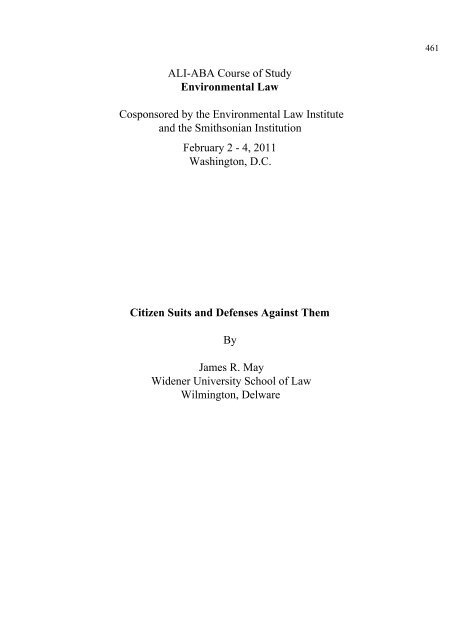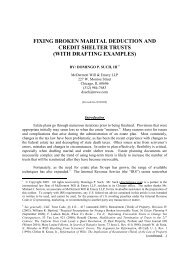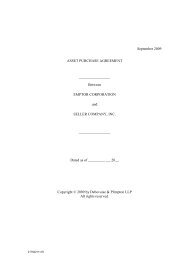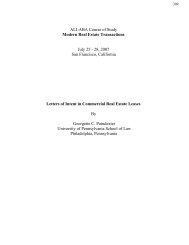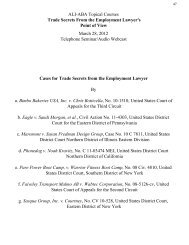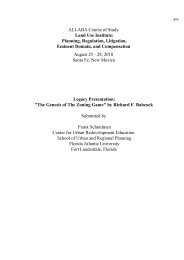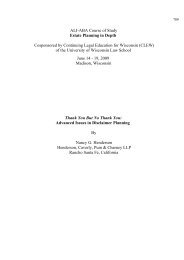Citizen Suits and Defenses Against Them - ALI CLE
Citizen Suits and Defenses Against Them - ALI CLE
Citizen Suits and Defenses Against Them - ALI CLE
You also want an ePaper? Increase the reach of your titles
YUMPU automatically turns print PDFs into web optimized ePapers that Google loves.
461<strong>ALI</strong>-ABA Course of StudyEnvironmental LawCosponsored by the Environmental Law Institute<strong>and</strong> the Smithsonian InstitutionFebruary 2 - 4, 2011Washington, D.C.<strong>Citizen</strong> <strong>Suits</strong> <strong>and</strong> <strong>Defenses</strong> <strong>Against</strong> <strong>Them</strong>ByJames R. MayWidener University School of LawWilmington, Delware
4622
463CITIZEN SUITS AND DEFENSES AGAINST THEM<strong>ALI</strong>/ABA Course of StudyEnvironmental Law Course of StudyWashington, DCFebruary, 2011James R. May 1Professor of LawH. Albert Young Fellow in Constitutional LawWidener UniversityI. IntroductionWhat follows is a recap of major developments involving environmental citizen suit decisions undera variety of federal statutes in 2010.<strong>Citizen</strong> suits are a common attribute in the enforcement of federal environmental laws, historicallycomprising almost one-half of all civil enforcement actions. While statistical information is elusive for moststatutes, since 2003, under the Clean Water Act citizens have sent about 2,000 notices of intent to sue, filed325 complaints, <strong>and</strong> entered about 140 consent decrees, including 312, 52 <strong>and</strong> 2, respectively, in 2010. 2Environmental citizen suits share common attributes. First, except in rare circumstances, environmentalcitizen suitors must send a notice of intent to sue to appropriate persons at least 60 days before commencingan action. 3 The prototypical provision, section 505(b) of the CWA, provides: “No action may be commenced. . . prior to sixty days after the plaintiff has given notice of the alleged violation (i) to the Administrator, (ii) tothe State in which the alleged violation occurs, <strong>and</strong> (iii) to any alleged violator of the st<strong>and</strong>ard, limitation, ororder.” 4<strong>Citizen</strong> suit notice requirements are considerably more dem<strong>and</strong>ing than notice pleading under theFederal Rules of Civil Procedure. 5 <strong>Citizen</strong>s must give notice in the manner prescribed by EPA. EPA rulesgenerally require notices of intent to sue to identify the specific st<strong>and</strong>ards <strong>and</strong> limitations the recipient of thenotice is alleged to be violating, the person responsible, the location of the alleged violation, the date or datesof such violation, <strong>and</strong> the full name <strong>and</strong> address of the person giving the notice. 6 Though it is questionablewhether advance notice is “jurisdictional,” there it must be perfected before commencing a citizen suit. 71Jim May is a Professor of Law <strong>and</strong> the H. Albert Young Fellow in Constitutional Law at Widener UniversitySchool of Law. This paper builds upon (but does its best not the repeat) prior <strong>ALI</strong>-ABA updates prepared by theauthor. More expansive versions of what’s here appeared in James R. May, Now More Than Ever: Trends inEnvironmental <strong>Citizen</strong> <strong>Suits</strong> at 30, 10 Widener L. Rev. 1 (2003), Now More Than Ever: Recent Trends inEnvironmental <strong>Citizen</strong> <strong>Suits</strong>, in Environmental <strong>Citizen</strong> <strong>Suits</strong> at Thirtysomething: A Celebration <strong>and</strong> Summit, 33 Envtl.L. Rep. 10,704 (2003), <strong>and</strong> The Availability of State Environmental <strong>Citizen</strong> <strong>Suits</strong>, 18 Nat. Resources & Env’t 53 (2004).2. EPA Office of General Counsel, Water Law Office Notices of <strong>Citizen</strong> Suit documents, Dec. 2010 (on file withauthor). Statistical information for citizen suits under other statutes since 2003 is not readily available.3. See, e.g., 33 U.S.C. § 1365(b)(1)(A) (2000) (CWA); 42 U.S.C. § 7604(b)(1)(A) (2000) (CAA); 16 U.S.C. §1540(g)(2)(A)(i) (ESA); 42 U.S.C. § 6972(b)(1)(A) (RCRA) (ninety days for violating certain solid waste requirements); 42U.S.C. § 9659(d)(1) (2000) (CERCLA); 42 U.S.C. § 300j-8(b) (2000) (SDWA); 42 U.S.C. § 11046(d) (2000) (EPCRA).But see 16 U.S.C. § 1540(g)(2)(C) (2000) (ESA) (notice not required if action “posing a significant risk to the well-beingof any species”). See also 42 U.S.C. § 6972(a)(1)(B) (2000) (RCRA) (notice, but not delay, required for illegal disposal ofstatutory hazardous wastes amounting to “imminent <strong>and</strong> substantial endangerment”).4. 33 U.S.C. § 1365(b) (2000).5. Fed. R. Civ. P. 4 (general civil “notice” pleading). See, e.g., Nat’l Parks Conservation Ass’n v. Tenn. ValleyAuth., 175 F. Supp. 2d 1071, 1077 (E.D. Tenn. 2001); Torres Maysonet v. Drillex, S.E., 229 F. Supp. 2d 105, 107-08(D.P.R. 2002).6. See 40 C.F.R. §54.3(b) (2002) (CAA); id. § 135.3(a) (CWA). Some statutes, like the ESA, lack a notice rulecounterpart.7. Hallstrom v. Tillamook County, 493 U.S. 20, 33 (1989). Professor Coplan concludes that notice is notjurisdictional, <strong>and</strong> describes why it matters to citizen suitors. Karl S. Coplan, Is <strong>Citizen</strong> Suit Notice Jurisdictional <strong>and</strong>Why Does it Matter?, 10 Widener L. Rev. 49 (2003) (noting that the “jurisdictional” nature of notice “implicates the1
464Second, government enforcement prior to commencement of the action may preclude the citizensuit. The prototypical provision precludes citizen suits when, prior to commencement of the citizen suit, astate or federal agency “commences” <strong>and</strong> is “diligently prosecuting” a civil or criminal action “in a Court ofthe United States,” 8 or under the CWA there is diligent prosecution of an administrative action, collection ofa penalty, <strong>and</strong> citizens do not file an action before institution of the agency action or within 120 days ofsending proper notice. 9Third, citizens may “commence” a case only by <strong>and</strong> large in the absence of government enforcementaction. Unless precluded, forestalled, unconstitutional or otherwise unwise, the archetypal citizen suitprovision allows “any person” to “commence a civil action on his own behalf” against either (1) “any person”who violates a legal prohibition or requirement, or (2) the U.S. Environmental Protection Agency (EPA) forfailure “to perform any act or duty . . . which is not discretionary.” 10Each statute has its own temporal jurisdictional requirement as to when an action may be commenced. 11 Forexample, the CWA requires good faith allegations of ongoing violations (that the polluter is “alleged to be inviolation”), 12 while the CAA allows for prosecution of past violations “if there is evidence that the allegedviolation has been repeated,” 13 <strong>and</strong> RCRA for past violations that “may present an imminent <strong>and</strong> substantialendangerment.” 14Last, citizen suits face a banquet of constitutional <strong>and</strong> prudential challenges, including st<strong>and</strong>ing,mootness, preemption, sovereign immunity, the political question doctrine, claim <strong>and</strong> issue preclusion, <strong>and</strong>abstention.<strong>Citizen</strong> suits comprise a significant portion of the judicial canon. Federal courts issued about 220decisions in environmental civil cases in 2010, about 160 of which are environmental citizen suits. 15 Of these,<strong>and</strong> as summarized below, nearly one-half are under the Clean Water Act (74), with the ResourceConservation Act (49), Clean Air Act (34), Endangered Species Act (32), <strong>and</strong> Comprehensive,Environmental Resource Compensation, Liability Act (25) also posting a significant number of judicialopinions, with 54 more cases involving a mash up of statutes. Given this distribution, I’ll start with the CleanWater Act, before turning to the other statutes with citizen suit provisions. For sake of focusing the scope ofthis update, I’ve divided my discussion between “procedural” issues, including notice, preclusion, complaints,jurisdiction, attorney fees, <strong>and</strong> “substantive” decisions that reach the merits, although again, this is by nomeans a scientific distinction.I. Clean Water Act<strong>Citizen</strong>s may bring suit under the Clean Water Act to enforce effluent st<strong>and</strong>ards or limitations set bythe EPA or the State if the violation adversely affects them. <strong>Citizen</strong> suits are barred under the act if diligentstate or federal enforcement is underway. Sixty day notice must be given to the violator, the State, <strong>and</strong> theEPA before filing the suit. Similar to the other citizen suit provisions discussed, to remedy a violation thecourt may issue an injunction, impose penalties, <strong>and</strong> grant attorney’s fees.A. Proceduralproper procedure for raising notice objections, the means of curing notice defects, the question of waiver of noticeobjections, <strong>and</strong> the timing of raising notice objections”).8. See 33 U.S.C. § 1365(b)(1)(B) (2000) (CWA); 42 U.S.C. § 7604(b)(1)(B) (2000) (CAA); 16 U.S.C. §1540(g)(2)(A)(iii) (2000) (ESA); 42 U.S.C. § 6972(b)(1)(B) (2000) (RCRA).9. See 33 U.S.C. § 1319(g)(6)(B) (2000) (CWA). See also 16 U.S.C. § 1540(g)(2)(A)(ii) (2000) (ESA) (preclusion ifServices commence action to impose penalty).10. 42 U.S.C. § 7604(a) (2000).11. R<strong>and</strong>all S. Abate, Rethinking <strong>Citizen</strong> <strong>Suits</strong> for Past Violations of Federal Environmental Laws:Recommendations for the Next Decade of Applying the Gwaltney St<strong>and</strong>ard, 16 Temp. Envtl. L. & Tech. J. 1 (1997); cf.Scott M. DuBoff & Scott W. Clearwater, Arguing for the Defense After Gwaltney, 18 Envtl. L. Rep. 10,123 (1988).12. 33 U.S.C. § 1365(a)(1) (2000) (CWA).13. 42 U.S.C. § 7604(a)(1) (2000) (CAA).14. 42 U.S.C. § 6972(a)(1)(B) (2000) (RCRA).15 These figures are hardly scientific, based on a Lexis search for cases brought as – <strong>and</strong> not simply referencing –citizen suits under one of the statutes cited infra note 4.2
4651. NoticeAssateague Coastkeeper v. Alan And Kristin Hudson Farm, 2010 WL 2924661 (D. Md. 2010)Assateague Coastkeeper <strong>and</strong> other organizations <strong>and</strong> individuals brought a citizen suit against a poultryproducing concentrated animal feeding operation, Alan <strong>and</strong> Kristin Hudson Farm, seeking penalties <strong>and</strong>injunctive relief under Clean Water Act (CWA) for illegal discharges of poultry manure. The farm filedmotions to dismiss. The District Court, held that failure to adequately identify one of the multiple plaintiffs innotice given of the citizen suit required dismissal of that plaintiff, <strong>and</strong> the notice was not sufficient as to othernamed plaintiffs, whose addresses <strong>and</strong> phone numbers were not included. The allegations of the Farm’scontrol over grower's concentrated animal feeding operation (CAFO) were sufficient to state a claim. TheFarm’s motions granted in part <strong>and</strong> denied in part.City of Ashtabula v. Norfolk S. Corp., 633 F. Supp. 2d 519 (N.D. Ohio 2009)The City of Ashtabula brought action against the owner of a coal dock facility, Norfolk S. Corporation,alleging a discharge of pollutants <strong>and</strong> contaminated water amounted to a violation of the CWA. The courtdetermined that although the City provided timely <strong>and</strong> adequate notice of suit in the form of a letter forcertain violations, their claim ultimately failed, <strong>and</strong> Norfolk’s motion to dismiss was granted, because theCity’s letter did not provide adequate notice of all alleged violations.Palm Beach County Envtl. Coal. v. Florida, 651 F. Supp. 2d 1328 (S.D. Fla. 2009)Palm Beach County Environmental Coalition (PBCEC) brought suit against various developers, as well asstate <strong>and</strong> federal officials <strong>and</strong> agencies. They alleged that the construction of a natural gas pipeline segmentwould result in the release of noxious gasses <strong>and</strong> deteriorate the overall quality of life in violation of theCWA, <strong>and</strong> numerous other state <strong>and</strong> federal law. PBCEC required the filing of an amended complaint, as wellas an emergency motion for temporary injunctive relief in order to enjoin further construction related to thepipeline. The court denied the motion, <strong>and</strong> most of the Defendants filed motions to dismiss the amendedcomplaint. The court granted the defendants motions to dismiss as they pertained to the CWA claims againstthe state agencies <strong>and</strong> officers on the basis of their 11th Amendment sovereign immunity, <strong>and</strong> as theypertained to those claims against the federal agencies <strong>and</strong> officers because the Plaintiffs failed to comply withfederal notice requirements. Additionally, the court dismissed the claims against the developers under theCWA because they found they had a lack of jurisdiction under 15 U.S.C. §717r(d), which granted originaljurisdiction in the matter to the controlling federal circuit court.Coal. for a Sustainable Delta v. City of Stockton, 2009 U.S. Dist. LEXIS 74353 (E.D. Cal. 2009)Five local water districts, the Coalition for a Sustainable Delta, alleged the City of Stockton illegally dischargedpollutants in violation of the CWA. The City moved to dismiss, claiming that the Coalition had failed to meetCWA requirements of pre-suit notice because of a vague <strong>and</strong> unsupported, yet timely letter. The courtdisagreed, explaining that the Coalition need only inform the alleged polluters of what their alleged violationsare, but need not argue their point at that time.Duggan Family P’ship, LLP v. City of Jeffersonville, 2009 WL 1560045 (M.D. Ga. 2009)The Duggan Family Partnership brought a citizen suit against the City of Jeffersonville alleging that increasedstorm water <strong>and</strong> contaminated runoff from their adjacent treatment facility caused substantial erosion ontheir property, <strong>and</strong> posed a serious threat to several animal populations. The City filed a motion to dismiss,<strong>and</strong> the Court granted because the notice sent to them regarding the alleged violations failed to provide thenature of the alleged violation, as well as the activity alleged to constitute a violation. While the notice letterspecifically states that it is in reference to an alleged CWA violation, it does not specify the specific st<strong>and</strong>ardor limitation of the CWA that was allegedly violated, nor does it provide a specific activity alleged toconstitute the violation. Additionally, the court found that the notice letter was sent less than sixty days priorto the filing of the claims against the City, <strong>and</strong> was thus further deficient on that basis.Rock Creek Alliance v. United States Forest Serv., 703 F. Supp. 2d 1152 (D. Mont. 2010)3


